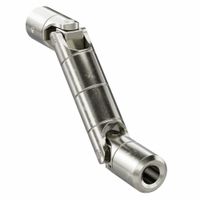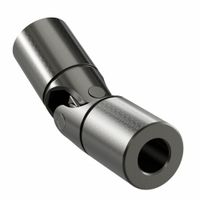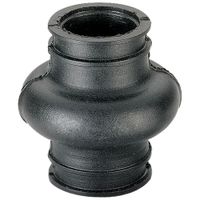Call +(254) 703 030 000 / 751 483 999 / 721 704 777
- Home
- Power Transmission
- Shaft Couplings Universal Joints
- Universal Joints
.....Read More
Frequently Asked Questions
What is a universal joint and how does it work?
A universal joint, also known as a U-joint, is a mechanical connection between two rotating shafts, which are generally not in a straight line. It allows for the transmission of torque and rotary motion, even when the shafts are at an angle to each other. This joint is crucial in applications where flexibility in the alignment of the shafts is necessary, such as in the drive shafts of vehicles, machinery, and various industrial equipment.
The universal joint consists of a pair of hinges located close together, oriented at 90 degrees to each other, connected by a cross shaft. This configuration allows the joint to accommodate angular misalignment between the shafts. When one shaft rotates, the cross transmits the motion to the other shaft, even if they are not perfectly aligned.
The working principle of a universal joint is based on the concept of a gimbal, which allows for the transmission of motion in multiple directions. As the input shaft rotates, the cross and the connected hinges allow the output shaft to follow the input shaft's motion, even if the angle between them changes. This flexibility is essential in applications where the alignment of the shafts can vary due to movement or vibration.
However, universal joints have limitations. They can introduce variations in angular velocity between the input and output shafts, known as "velocity fluctuations," especially at larger angles. This can lead to vibrations and wear if not properly managed. To mitigate these effects, constant velocity joints (CV joints) are often used in applications requiring smoother operation.
In summary, a universal joint is a versatile mechanical component that enables the transmission of rotary motion between misaligned shafts, providing essential flexibility in various mechanical systems.
What are the types of universal joints?
Universal joints, also known as U-joints, are mechanical devices used to transmit rotary motion between two shafts that are not in a straight line. The main types of universal joints include:
1. **Cross and Bearing Joint (Cardan Joint):** This is the most common type of universal joint, consisting of a cross-shaped member (the spider) with needle bearings at each end. It allows for the transmission of torque and rotary motion at angles up to about 45 degrees.
2. **Constant Velocity Joint (CV Joint):** These joints are designed to transmit power smoothly at a constant rotational speed, regardless of the angle. They are commonly used in front-wheel-drive vehicles. Types of CV joints include:
- **Rzeppa Joint:** Features a spherical design with six balls that allow for smooth power transmission.
- **Tripod Joint:** Uses three rollers on a tripod-shaped yoke, allowing for axial movement and angular changes.
3. **Double Cardan Joint:** This is essentially two Cardan joints in series, with a connecting shaft. It is used to reduce the angular velocity fluctuations that occur in single Cardan joints, providing smoother operation.
4. **Ball and Socket Joint:** Similar to a human hip joint, this type allows for a wide range of motion in multiple directions. It is less common in industrial applications but used in some specialized machinery.
5. **Bendix-Weiss Joint:** A type of CV joint that uses a series of balls and grooves to maintain constant velocity. It is less common than the Rzeppa joint.
6. **Thompson Coupling:** A more complex design that maintains constant velocity and can handle larger angles and higher speeds.
Each type of universal joint has its specific applications, advantages, and limitations, making them suitable for different mechanical systems and requirements.
How do you install a universal joint?
1. **Safety First**: Ensure the vehicle is on a flat surface, engage the parking brake, and use wheel chocks. Lift the vehicle using a jack and secure it with jack stands.
2. **Remove Driveshaft**: Mark the driveshaft and differential yoke for alignment. Remove the bolts or straps securing the driveshaft to the differential yoke. Slide the driveshaft out of the transmission or transfer case.
3. **Remove Old U-Joint**: Use a U-joint press or a bench vise with sockets to press out the old U-joint. Remove the retaining clips from the U-joint caps. Press out the U-joint by applying pressure to the yoke.
4. **Clean Yoke**: Clean the yoke thoroughly, removing any rust or debris. Inspect for damage or wear.
5. **Install New U-Joint**: Insert the new U-joint into the yoke. Place the bearing caps over the U-joint trunnions. Use the U-joint press or vise to press the caps into the yoke until the retaining clip grooves are visible.
6. **Secure with Retaining Clips**: Install the new retaining clips into the grooves. Ensure they are seated properly.
7. **Check Movement**: Move the U-joint by hand to ensure it rotates smoothly without binding.
8. **Reinstall Driveshaft**: Align the marks made earlier and reinstall the driveshaft onto the differential yoke. Secure it with bolts or straps, tightening to the manufacturer's specifications.
9. **Final Check**: Lower the vehicle and remove the jack stands. Test drive to ensure there are no vibrations or unusual noises.
10. **Recheck**: After a short drive, recheck the U-joint and driveshaft for proper installation and tightness.
What are the signs of a failing universal joint?
Signs of a failing universal joint include:
1. **Clunking Noise**: A noticeable clunking or banging noise when shifting from park to drive or reverse, or when accelerating or decelerating, can indicate excessive play in the joint.
2. **Vibration**: A failing U-joint can cause vibrations that increase with vehicle speed. This is often felt through the floorboard or steering wheel and can be mistaken for tire imbalance.
3. **Squeaking Noise**: A high-pitched squeaking noise, especially at low speeds, can indicate a lack of lubrication in the U-joint bearings.
4. **Visible Rust or Corrosion**: Rust or corrosion around the U-joint can weaken it, leading to failure. Regular inspection can reveal these signs before they become critical.
5. **Leaking Transmission Fluid**: If the U-joint is failing, it can cause the transmission output shaft seal to leak, leading to fluid loss.
6. **Difficulty in Steering**: A failing U-joint can affect the driveline's ability to transfer power smoothly, making steering more difficult or less responsive.
7. **Loose or Wobbly Driveshaft**: If the U-joint is severely worn, the driveshaft may feel loose or wobbly when manipulated by hand.
8. **Increased Wear on Other Components**: A failing U-joint can lead to increased wear on the driveshaft, differential, and transmission, as it can cause misalignment and additional stress on these components.
9. **Check Engine Light**: In some vehicles, a failing U-joint can trigger the check engine light due to the impact on the vehicle's driveline sensors.
10. **Loss of Power**: In severe cases, a completely failed U-joint can lead to a loss of power transfer to the wheels, rendering the vehicle immobile.
How do you maintain and lubricate a universal joint?
To maintain and lubricate a universal joint, follow these steps:
1. **Safety First**: Ensure the vehicle is on a stable surface and use wheel chocks. If necessary, lift the vehicle using a jack and secure it with jack stands.
2. **Locate the Universal Joint**: Identify the universal joint, typically found on the driveshaft of rear-wheel-drive vehicles.
3. **Inspect the Joint**: Check for any signs of wear, rust, or damage. Look for excessive play or movement in the joint, which could indicate wear.
4. **Clean the Area**: Use a clean rag to wipe away dirt, grease, and debris from the joint and surrounding areas to ensure proper lubrication.
5. **Identify the Grease Fitting**: Locate the grease fitting (also known as a Zerk fitting) on the universal joint. If the joint is sealed and lacks a fitting, it may not be serviceable.
6. **Select the Right Grease**: Use a high-quality, lithium-based grease suitable for universal joints. Ensure it is compatible with the vehicle's specifications.
7. **Use a Grease Gun**: Attach the grease gun to the fitting. Pump grease into the joint until you see fresh grease oozing out from the seals, indicating the joint is fully lubricated.
8. **Wipe Excess Grease**: Clean any excess grease from the joint and surrounding areas to prevent dirt accumulation.
9. **Reinspect**: After lubrication, check the joint again for any signs of wear or damage.
10. **Regular Maintenance**: Lubricate the universal joint at regular intervals as specified in the vehicle's maintenance schedule, or more frequently if the vehicle is used in harsh conditions.
By following these steps, you can ensure the longevity and proper functioning of the universal joint.
What is the difference between single and double universal joints?
A single universal joint, also known as a Cardan joint, consists of two yokes connected by a cross-shaped intermediate member called a trunnion. It allows for the transmission of rotary motion between two shafts that are not in a straight line, accommodating angular misalignment. However, it introduces a phenomenon known as "non-constant velocity," where the output shaft speed fluctuates during rotation, especially at higher angles of misalignment.
A double universal joint, or double Cardan joint, consists of two single universal joints connected in series with an intermediate shaft. This configuration is used to address the non-constant velocity issue inherent in single universal joints. By using two joints, the double universal joint can maintain a more constant velocity between the input and output shafts, even at larger angles of misalignment. The intermediate shaft is typically designed to be equal in length to the distance between the two joints, ensuring that the angular velocity fluctuations introduced by the first joint are canceled out by the second joint.
In summary, the primary difference between single and double universal joints lies in their ability to handle angular misalignment and maintain constant velocity. Single universal joints are simpler and suitable for applications with minor misalignment, while double universal joints are more complex but provide smoother operation and are better suited for applications with significant misalignment.
How do universal joint boots protect the joint?
Universal joint boots protect the joint by serving as a barrier against contaminants and maintaining lubrication. These boots are typically made from durable materials like rubber or thermoplastic, which are resistant to wear and environmental factors. By encasing the joint, the boot prevents dirt, dust, water, and other debris from entering the joint assembly. This is crucial because contaminants can cause abrasion and corrosion, leading to premature wear and potential failure of the joint.
Additionally, the boot helps retain the grease or lubricant within the joint. Proper lubrication is essential for the smooth operation of the universal joint, as it reduces friction between the moving parts and minimizes heat generation. Without adequate lubrication, the joint components can grind against each other, leading to increased wear and eventual breakdown.
The boot's design typically includes accordion-like folds, allowing it to flex and move with the joint's motion without tearing or losing its protective seal. This flexibility ensures that the boot remains intact and effective throughout the joint's range of motion, whether in a vehicle's drive shaft or other mechanical systems.
In summary, universal joint boots are critical for extending the life of the joint by keeping contaminants out and lubrication in, thereby ensuring efficient and reliable operation.


